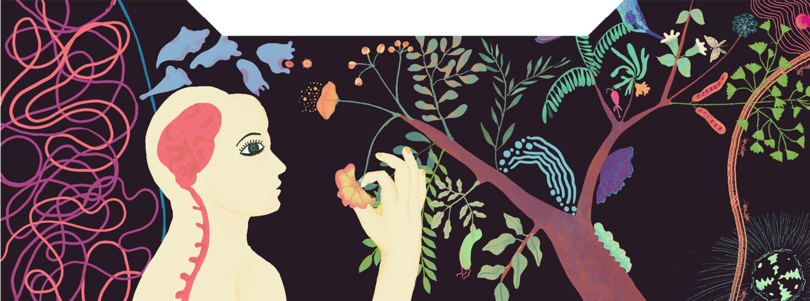
iThink Biology is a case-study-based learning resource that is accessible, self-contained, and prioritises essential capacities over content. We invite you to use this book to study biology through an interdisciplinary lens by learning from examples based in the Indian context.
A. Land and waterscapes
Traverse varied land, water and urban environments to understand ecosystems within India’s enormous diversity.
A1. Western Ghats
Plants, animals and windmills in the Western Ghats.
A2. Waterscapes of India
Journey through the freshwater communities of the Ganges.
A3. Urbanscapes
A view of the city as an organism and our connection with nature.
B. Human health
Study diseases that are prevalent globally, their disease burden, and treatment in India.
B1. Malaria
A chronicle of our interactions with malaria and its mosquito vector.
B2. Rotavirus
The development of an indigenous rotavirus vaccine.
C. Food and agriculture
Engage with how evolution, society and technology have shaped what we eat and wear.
C1. Rice
The 3 Ds of rice: domestication, diversity and diet.
C2. Cotton
Farm to fibre: Impact of hybridisation and molecular cloning on cotton and cotton-growers.
D. Interactions between organisms
Explore interactions between the varied flora, fauna, and fungi of India.
D1. Felines
Cats in the wild: The fantastic diversity of Indian felines and measures to protect their population.
D2. Figs
The intertwined lives of figs and fig wasps and ways to communicate this relationship.
D3. The Kingdom of Fungi
Ecology, diversity and disease in Indian fungi.
Primers
Review and revise basic concepts and techniques that are required for this resource.
i. Numbers and scales in biology
ii. Gene expression
iii. Molecular biology techniques
iv. Evolution
Key capacities taught in iThink Biology
Scientific tools
Find out about the tools and techniques available to biologists for answering their scientific questions. Explore specific technologies at various scales from molecules to ecosystems. These technologies can be as varied as genetic engineering, microscopy, or specific methodological tools such as survey design.
When you see this scientific tools icon, you’ll be developing one or more of these capacities:
- microscopy
- genetic engineering
- survey design
- sampling
- experimental design
- categorising data.
Bridging science, society and the environment
Learn how our understanding and exploitation of nature is intricately linked to our societies. Explore how solutions to biological problems have to be integrative, taking into account science and society (social and political) and the environment.
When you see this bridging science, society and the environment icon, you’ll be developing one or more of these capacities:
- understanding connections between society and the environment
- integrating science, nature and society
- practising public responsibility
- applying personal integrity.
Scientific process
Explore the art of asking questions in basic and applied biology. Learn how these questions are addressed using hypothesis-driven methodologies as well as exploratory studies.
When you see this scientific process icon, you’ll be developing one or more of these capacities:
- describing the history of a scientific discovery
- observation, measuring and making inferences
- designing experiments
- asking questions
- using hypothesis-driven methodologies to answer questions
- using exploratory studies to answer questions
- evaluating the research of others.
Reading and interpreting
Cultivate the art of reading and interpreting text. Explore various kinds of texts from scientific articles to popular science writing and media. Practise searching and citing texts.
When you see this reading and interpreting icon, you’ll be developing one or more of these capacities:
- reading
- interpreting
- searching through literature
- citing texts
- evaluating source material
- comparing and categorising source material.
Quantitative skills
Learn to analyse and interpret quantitative information in the context of a biological problem to draw the right conclusions.
When you see this quantitative skills icon, you’ll be developing one or more of these capacities:
- mathematical reasoning
- analytical reasoning
- evaluating
- interpreting data
- graphing
- comparing and categorising.
Reading iThink Biology
Welcome to iThink Biology! If you are a student in an undergraduate programme or even a Class 11/12 student who is passionate about life sciences, this book is written for you. We think that you will find this resource to be different from the textbooks that you are used to reading. So, we want to tell you a little bit about what to expect and how to go about reading it.
About iThink Biology
iThink Biology was born out of the rewards and frustrations of the authors’ involvement in the development of a new undergraduate programme in biology. Students who study biology at the undergraduate level choose to do so for various reasons: for their passion for the subject, to pursue higher education, to do research, and for gainful employment. As instructors, we realised that we needed teaching resources that could address the diverse motivations students had for studying biology. We also wanted to identify key capacities underlying content knowledge that students in our programme should develop. Importantly, we needed a resource that was grounded in the Indian context for the Indian student.
About the authors
This book is written by Divya Uma, Jayanti Mukherjee, Kaustubh Rau, Sriram, and Sravanti Uppaluri, with project support from Anjali Paranjape and Neelima Menon. Illustrations are by Ipsa Jain, Kshiraja Krishnan, Aranya Broome, and Neeharika Verma. Production is by Electric Book Works.
The authors are biologists and educators based at Azim Premji University with wide-ranging interests and specialties.
